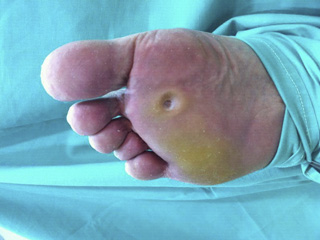It is really a symptom of other problems rather than a disease itself. Metatarsalgia is a general name given to pain in the front part of your foot under the heads of your metatarsal bones. The ache can be intermittent or constant.
Etiology or Causes
- This pathology is more common in women because of the footwear they use (high heels that add extra weight to the front of your foot and shoes with a narrow toe box). At the beginning it can reveal plantar callosities at head metatarsal level.
- It is usually related to other pathologies such as hallux valgus (bunion) which implies a first radius shorter than the other one (legs length are not equal) and causes an extra stress on adjoining metatarsals.
- Certain foot shapes like a high arch, vertical or long metatarsal may put extra pressure on forefoot.
- Severals pathologies like pes cavus, pes planus are closely related to metatarsal pathologies cases.
- Systemic pathology or foot disorders (rheumatoid arthritis, psoriatic arthritis) cause an alteration at metatarsophalangeal joint level with dislocations and plantar pain.
Prevention
You can prevent this kind of pain by using comfortable and wide shoes avoiding high heels or too-tight shoes around the toes. Feet will be forced into a small space.
Non-surgical Treatment
It is recommended to start with conservative measures because metatarsalgia responds positively to template usage, to an appropriate and controlled body weight and to a rehabilitation treatment in order to relieve the symptomatology.
Surgical Treatment
15-20 percent of patients need a surgical intervention because they do not get better with non-surgical or conservative treatment.Treatments should be personalised and they will depend on the underlying cause of metatarsalgia in each patient, because treaments are focused on correcting what produces pain. There are several methods based on corrective osteotomies which usually require osteosynthesis materials such as screws, plates or Kirshner needles. However, percutaneous surgical techniquess allow us to treat these pathologies with greater results than traditional techniques without the need of using implants, with quicker recovery, less painful recovery and in an outpatient way.






